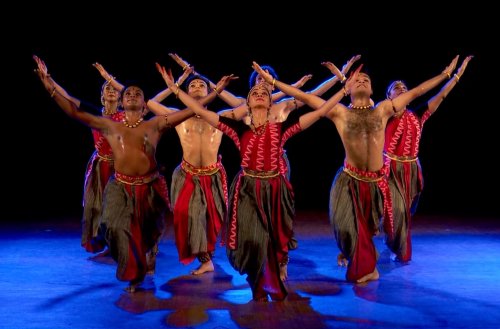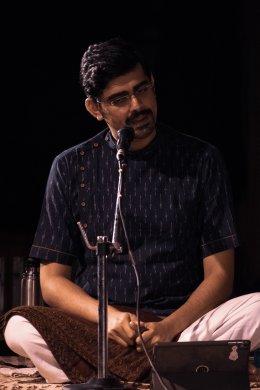
|   |

|   |
Margazhi goes online - Sukanya Kumar e-mail: sukanya.kumar91@gmail.com February 9, 2021 For the past nine years, Guru Gayatri Subramaniam, Director of G V Ramani Natya Kala Foundation, has been hosting two festivals every year - 'Utsav' in June and 'Margazhi' in December in Navi Mumbai. This year Margazhi came in the middle of Thai but on a larger canvas reaching out to global audience. Excellent videos of established artistes, by Iyyappan Arumugam, in a two-day event, coordinated by Varsha Kumar gave a near-live viewing experience to art aficionados.  Meenakshi Srinivasan After a really long prayer invocation, Meenakshi Srinivasan commenced with an offering to Lord Ranganatha. The jathis preceding Kulasekaralwar's Mukunda Mala stotram was very lilting. The silence after the word Bhogeendrasayinam was opposed in tenor to the jathis that followed it. It appeared deliberate as if to awaken the Lord from slumber. Apt and appropriate hasta abhinaya portrayed different forms of Vishnu. In the line, 'Nrityosava Nanditam,' the orchestra members played effectively to correspond with the instruments portrayed in the procession. The swaram was an effortless flow of nritta. Sarasa Ninnu, Tanjore Quartet Pada Varnam in Karnataka Kaapi portrayed the nayika pining for her Lord Brihadeeswara. The shringara and bhakti bhava were seamlessly intertwined and expressed with dexterity. The sanchari incorporated graceful movements, while the standing treatment in thattu mettu with nil or minimal hasta mudras was a mature approach to choreography. Vibrant tisra gathi jathi was a powerful rendition by Jayashree Ramanathan on nattuvangam and Vedakrishnaram on mridangam. Dainty poses in the chitta swaram were sculpturesque and the aramandi in nritta section was impressive. The eduppu kanakku of the Utharangam started with crisp portrayal of different episodes of Shiva with vibrant foot work that was eye catching. The Ettugadajathi, a lightning rendition added vigor, a result of the combined skills of the nattuvanaar, the mridangam vidwan and the dancer. The silent space that Meenakshi gave after the line 'rasakumara' came as a surprise. An understandable confusion between Manini gathe (Lyrics of Sumasayaka, another composition in the same ragam) instead of Manini vera, was indicative of how involved the vocalist was in the beauty of the raga. For the padam, Meenakshi appeared in a different costume, the luxury of a digital recital. K Hariprasad had composed the music for the Sarangapani Padam and research was by S Jayachandran. The nayika pretends not to know who Krishna is by asking His name. Undeterred by her indifference, He quotes instances of their intimate moments and the different names by which He is known, Muvvagopala, Madhusudana and so on. The pride of Krishna in the various identities was brought out with clarity. The sensuality of suggestive movements in the Padam was portrayed in a subtle manner. Meenakshi was constantly appreciating the music, nodding and enjoying. The entire recital was a comforting experience.  Spanda Leela Samson's Spanda dance company featured seven dancers (Ashwini Viswanathan, Aryamba Sriram, Radhe Jaggi, Hari Krishnan B, Season Unnikrishnan, Bhavajan Kumar and Atul Balu) in a unique content of both the abstract and the symbolic, traditional and contemporary. The opening music of "Bhaskaraya Namah" from the Krishna Yajur Veda with bansuri, veena and pakhawaj set the tone of dawn. Every Namah was represented in a different way whetting the curiosity of the viewer. Formation of a circle, moving in and out to create an image of Sun flares; depiction of seven horses, different birds, movements of Surya Namaskara, all added to the visual aesthetics. The costumes (yellow with red border and mustard with bluish purple border) illuminated by amber light generated a feeling of the warm sun. The different hand gestures for abhinaya performed at different levels gave a layered feeling culminating in a polyphonic entirety. 'Athishay' showcased the joyous dance of devotees in Purandaradasa's "Adidano Ranga." The striped moss green costume with red border, accent of black in the blouse added a folk flavour. Multiple heads of the snake Kalinga attacking Krishna from different directions was represented by dancers sequentially. Nritya abhinaya on one side and natya abhinaya - dramatic episode, on the other was exemplary. Creating patterns with odd number of seven dancers is noteworthy choreography. Graceful movement of the costume fan was eye-catching. Jump movements by the male dancers, influence of Kathakali, was a crescendo before the calm end line of Krishna sleeping on Yashoda's lap. "Nadhiyin Neeti", composed in varnam mettu by Rajkumar Bharati was all about man's disconnect with nature, abandoned from the five elements. In a unique approach, the abhinaya was done with different independent hastas, different emotions and different timing, but simultaneously, creating an amalgam. Meeting of two energies in Dwaita and Adhwaita was brought out in a chota Khayal of Shivputra Sitaramaiya Komkali Kumar Gandharva sung by Shubha Mudgal. Dawn on the left with a red circular light on the floor and cool light on their bodies and dusk on the right with a blue circular light on the floor and warm light on their bodies created a visual sunrise and sunset. Lighting again was effective in depicting one bird in silhouette (Bigger and majestic) and the other in front (Appearing smaller and restless) representing the Drishta and the Boghta. Towards the end of the piece when the focus is back on the couple the toggling of the light shows the time lapse. Thillana in Purvi began with the close-up video of the footwork of two dancers, the focus pull of the camera was impressive. Different permutations and combination of dancers resulted in interesting geometric patterns. Back-walk movement without clashing to return to position was novel. The path lighting, the camera moving to one extreme end, created an elongated feeling adding to the domino effect. While introducing the Nishada Rishabha and Gandhara, the depiction of dynamic ever moving images that portrayed the deity, the emotions and animals, were calming and spiritual. The unmatched yet synchronized adavu pattern was a good take off from the mystical silence. In Panchama, different types of shringara were shown ending with Sa pointing to Nirguna. The crystal-clear introductions by Leela Samson were backed by slow motion de-saturated video images of the piece to follow. This was a deviation from the customary Talking Head. 'Nokkam' on the whole was an exemplary creative choreography conceived and executed well.  Sikkil Gurucharan A brief and brilliant "Anbenum pidiyil" by Sikkil Gurucharan was a melodious beginning to the thematic collaboration with Bharatanatyam duo Renjith Babu and Vijna Vasudevan. In the mallari procession, Renjith was the Nandi playing the mridangam, changing character as vyagraha, switching roles playing cymbal, mardal, strewing flowers, then again changing back to Nandi with a jump inspired by pung cholam while Vijna was Akhilandeswari carrying the kumbha; juxtaposition of martial art muscularity and motherly calm feminism. In another scene she dances while he is quiet. The jathi used with emphasis on the syllable Jha was articulately recited by K S Balakrishnan on nattuvangam leading to "Jhambupathe". It was an appreciable artistic choice. Different hasta abhinaya was used to denote Ganga, Kaveri and Jamuna avoiding repetition. The mantra chanting and abhishekam was done with deep devotion. The alinganam in "Akhilandeswari Ramana" was the very image of divine love. The shuddha nritta used to depict panchaboothas was inspired by ritualistic practices, Mohiniyattam and Odissi movements. Episodes of Neelakanta, Kannappa Nayanar and Markandeya to show Shiva as Sharanagatha Vatsala were crisp and graphic. Rather than sticking to the feminine Akhilandeswari, Vijna was also Shiva in role reversal. The confluence and celebration of Nadabindu was packed with rhythmic surprises. Renjith's head stand for nirvikalpa was not only proof of his yoga skills but an appropriate inspiration fitting in the framework.  Renjith Babu & Vijna Vasudevan In the next Bahudari RTP by Sikkil, ragam, thanam and neraval flowed effortlessly. Within a short time frame the comprehensive presentation by the singer was complemented by melodious notes on the violin by Easwar Ramakrishnan and vibrant strokes of mridangam by Sumesh Narayanan. The emphasis on sa, dha, nam and ta in the finish of the tanam leading to the Kriti Sadananda Thandavam was interesting. It was a good idea to start the next dance piece Shivapanchakshara Stotram in ragam Punnagavarali, denoting "Nagendraharaya". Every prelude of the stanza was tastefully executed. In Neelakantaya where Renjith as Shiva drinks poison to save the world and Vijna as Devi saves Him, the concern in her eyes and the trust He has in her surpassed the worldly. Absolutely apt hasta abhinaya for Vasishta, Kumbodhbhava and Gowthamarya proved ample research and adherence to texts by resource person S Jayachandran and attention to details by Renjith Babu, the choreographer. Sikkil next presented a lullaby composed by V P Dhananjayan in ragam Neelambari. Emotive singing made the viewer look for the dancers on the right of the stage but it was not to be. The concluding Thillana depicted the rechaka and puraka intertwine as kumbhaka in the sushumna nadi. The vibrant energy built up to reach a state of bliss; Sivapazham. Even when Sikkil sang an extra line of pallavi, the dancers exchanged looks and enjoyed the moment with grace. Unhurried pace of Vijna's abhinaya brought out the depth. She seemed to be in complete control throughout the recital. Innovative choreography by Renjith Babu, incorporating suitable embellishments is noteworthy. The communication and mutual respect of the dancers and the orchestra group was palpable. Throughout the recital there were a lot of give and take, focus shared; the very essence of a collaboration.  Sukanya Kumar is a practitioner of Bharatanatyam and Kathak genres trained under illustrious gurus. She is a Creative Culturist, and choreographer skilled in implementing electronic media technology in her productions to propagate social messages. She has a BSc in electronic media, MFA in Bharatanatyam, MBA in Educational management and MFA in Dance and Technology. |